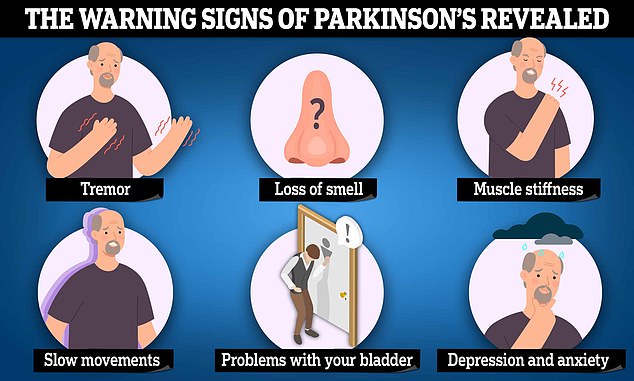[ad_1]
A simple skin swab based on the powers of ‘super smellers’ could detect devastating Parkinson’s disease up to seven years before symptoms appear.
Parkinson’s is an incurable neurological condition where parts of the brain become damaged over years, and which blights the lives of millions.
Patients suffer progressive tremors and movement problems that can eventually rob them of their independence.
While scientists have known for years that some people have the amazing power to sniff out Parkinson’s before obvious signs develop, they have struggled to create a test that can do the same.
But in a breakthrough, experts from the University of Manchester have come a step closer to making this a reality.
They discovered compounds found in sebum—an oily substance naturally produced by the skin—contained tiny traces of chemicals that indicate a person could be in the earliest stages of Parkinson’s.
While the disease isn’t curable early diagnosis is considered key to helping patients access treatments that can combat serious symptoms and maintain their quality of life for as long as possible.
Publishing their findings in the journal npj Parkinson’s Disease experts analysed skin swabs taken from 46 Parkinson’s patients, 28 healthy volunteers and 9 people with a condition called isolated REM Sleep Behaviour Disorder (iRBD).

Symptoms can include uncontrollable tremors, slow movements and muscle stiffness, but experts say they often only appear when about 80 per cent of the nerve cells have been lost

Super Smeller Joy Milne (pictured on ITV’s This Morning in October 2019) first discovered she can smell Parkinson’s when her late husband Les was diagnosed in 1980s

Mrs Milne’s ability was backed up in a scientific trial where she was able to sniff the difference in swab tests taken from Parkinson’s patients and healthy controls. Pictured here with her husband Les
iRBD is a sleep disorder where people often physically act out their dreams, sometimes violently, while asleep and is a known to be a potential early warning sign of Parkinson’s.
Results showed that iRBD patients had distinct chemicals in their sebum that differed from healthy volunteers, but these weren’t yet at the level as those with Parkinson’s.
This, the researchers suggested, indicated early-stage Parkinson’s was leaving tiny, but detectable, traces in the body up to seven years before the appearance of symptoms that would lead to a diagnosis.
To back up their findings scientists also referred to Parkinson’s ‘super-smeller’ Joy Milne.
Mrs Milne, a former nurse from Perth, Scotland, discovered she could smell the disease when she noticed a change in her late husband Les’ scent a decade before he was diagnosed in 1985, describing it as a ‘musky, greasy’ odour.
The grandmother’s ability was backed up in a scientific trial where she was able to sniff the difference in swab tests taken from Parkinson’s patients and healthy controls.
In the new study, Mrs Milne was able to distinguish both swabs taken from iRBD patients and those with Parkinson’s.
But even more interestingly she was able to spot two iRBD patients who had undiagnosed Parkinson’s, whose condition was confirmed at their next appointment.

Actor Michael J Fox (pictured here earlier this year) was diagnosed with Parkinson’s disease at just 29 years old. He now advocates for more research into the condition
Professor Perdita Barran, an expert of mass spectrometry—a scientific field on the study of tiny particles like those detected by scent— at Manchester, hailed the results.
‘This is the first study to demonstrate a molecular diagnostic method for Parkinson’s disease at the prodromal or early stage,’ she said.
‘It brings us one step closer to a future where a simple, non-invasive skin swab could help identify people at risk before symptoms arise allowing for earlier intervention and improved outcomes.’
As sebum is easily collected by a simple swab of a patient’s face and back—and doesn’t need to be stored at cold temperatures for transport for analysis—the hope is that a final test will be easy and cheap for medics to use.
It would represent a revolution for Parkinson’s diagnosis as there is currently no definitive test for the condition.
Currently diagnosis is normally based on the development of later stage symptoms like tremors after other potential health conditions have been ruled out.
Parkinson’s charities estimate over one in four patients with the condition are misdiagnosed before getting the correct diagnosis.
The researchers say they are continuing to develop and improve the sebum-based test with the goal of launching it to real-world clinical settings.
Dr Drupad Trivedi, an expert in analytical measurement sciences at Manchester, added, the team was keen to hear from other potential ‘super smellers’, like Mrs Milne, who might be able to detect other diseases.
About 90,000 Americans and 18,000 British people are diagnosed with Parkinson’s every year, with more than 10million patients estimated to have the condition worldwide.
The disease costs the NHS more than £725million a year.
Early signs of Parkinson’s include a tremor, stiffness, slowness of movement and loss of smell.
Balance problems such as issues with coordination and muscle cramps are other common signs.
Patients can also, as a consequence of their disease, frequently suffer from mental health problems like depression and anxiety.
Parkinson’s is caused by the death of nerve cells in the brain that produce dopamine, a chemicals which controls movement.
Experts are still working to uncover what triggers the death of these nerves.
However, current thinking is that it’s due to a combination of genetic changes and environmental factors.
Risk of developing the condition broadly increases with age, with most patients are diagnosed over 50.
[ad_2]
This article was originally published by a www.dailymail.co.uk . Read the Original article here. .



